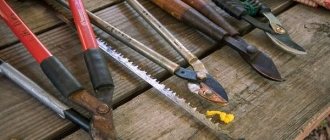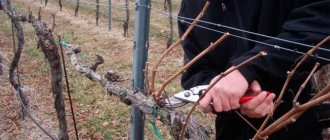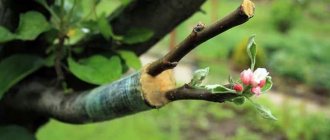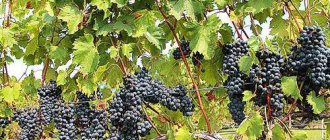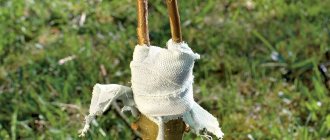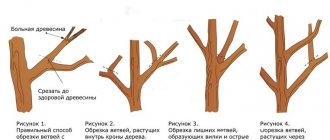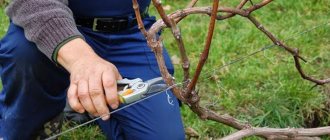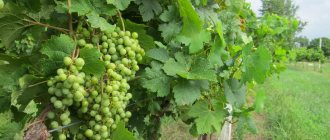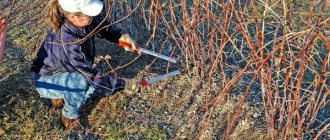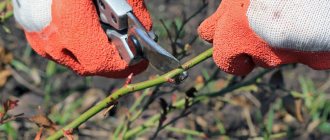The structure of a grape bush
This berry bush in its structure has underground and above-ground parts.
The underground includes the following components:
- The stem is a kind of base of the plant.
- The head is the thickened part of the trunk in the upper part.
- The root system is part of the bush, divided into:
- Main roots. In another way they are called “heel”. Placed at the very base of the trunk. Serve to saturate the plant with liquid and beneficial minerals.
- Lateral or median roots. They grow from the side of the headquarters and serve as an additional source of food.
- Superficial roots. They have another name: “dew”. They are located at the very surface of the bush.
The above-ground part of the grape consists mainly of stems. It is through them that all the nutrients from the roots come to the leaves and berries. Depending on the time of growth, the stems are divided into the following types:
- A shoot is a sprout from a bud.
- A stepson is a shoot that has grown on another shoot.
- A coppice shoot is one that grows from an underground root.
- A vine is a woody shoot.
- The fruit arrow is a vine, designed for better fruiting of grapes.
- A replacement knot is a vine with 2 buds.
- A fruiting link is a stem that has a fruiting frog and a replacement knot.
- The sleeves are two-year-old shoots.
- The head is the base of the bush.
Pruning fruiting grapes
Thanks to green operations on fruit-bearing grapes, it is possible to regulate the growth and yield of bushes. Sometimes you have to remove excess fruit-bearing shoots if the grape bush is overloaded.
Wreckage
The formation of a bush of debris is accelerated, errors made during pruning are eliminated. Improves ventilation and warming. Debris rules:
- Removing unnecessary shoots growing on the head and sleeves of the bush. The shoots are left for replacement and renewal. In varieties with uneven germination of shoots from dormant eyes, cutting is carried out twice.
- First of all, green shoots growing in the crowns are broken off.
- If the bushes are underloaded, debris is not needed.
- The cutting is done by breaking out the shoots down to the woody trunk.
Late cutting is done with pruning shears, but it harms the bush and weakens the plant.
Pinching stepsons
Young grassy shoots growing on the fruit shoot are pinched. Purposes of pinching stepchildren:
- accelerating the restoration of the leaf crown or skeleton;
- stopping the growth of shoots - to prevent shedding.
On underloaded bushes, pinch out vigorous shoots - several pieces, above the 3rd or 5th bud. The stepsons obtained after pinching can be used next year to form a fruit link.
An expert will tell you how to properly pincher grapes and how pinching affects yield in the following video:
Coinage
It is done to speed up the ripening of berries - while slowing down the growth of green shoots. Remove the retracted crowns, 4-7 buds at a time. Conditions for minting:
- irrigation;
- strong shoot growth;
- poor ripening.
If grapes are grown without watering, minting is not done. Also, it is not needed for low-growing varieties.
Grape polarity (formation)
Forming grapes involves pruning the stems according to the diagram. The easiest and most popular is the fan polarity of the grapes. It is convenient both for covering and for ripening berries.
Let's consider the scheme of this formation for beginner gardeners:
- During the first season, the main task is to grow a strong stem. For the winter, he bends down, insulates and covers himself. One-year grapes are not pruned.
- Pruning two-year-old grapes involves leaving 2 buds on the shoots. We cut off the remaining parts and leave them for 3 years.
- During the third season, shoots grow from the left buds. When pruning in autumn, we leave the strongest shoots from the grown shoots. We bend them to the ground, insulate them and cover them.
- In the spring we remove these shoots, leaving 2 buds. And already in the fall we get 4 strong sleeves.
- We unbend the sleeves and fix them in different directions. When trimming, it should turn out that the inner sleeves will be shorter than the outer ones, but not less than 50 centimeters.
- At 4 and 5 years we continue the formation of fruit links.
- In autumn, we cut off the lower woody trunks of a five-year-old plant, leaving 2 buds. This will make a substitution knot. At the top woody trunks we leave 4 eyes for the formation of fruit shoots. If you strictly follow this scheme, you will definitely get a high-quality and prolific shrub.
Technique and schemes
Young bushes that have not entered the fruiting period should be pruned only in the spring. It is important to follow some rules:
- the thicker the shoot, the longer the shoot is removed;
- the cut is made 2-3 cm above the eye;
- the best shoot is left on a strongly elongated sleeve;
- When removing shoots completely, you cannot leave stumps;
- When removing stepsons, the stump should be left.
In order to form a fruiting link, it is necessary to completely remove last year's vine. The grape pruning technique includes the following several schemes:
- short;
- average;
- long;
- mixed.
The gardener’s task is to leave the optimal number of buds on the bush and, using various methods of pruning and removing shoots and vines, to form a compact bush to obtain maximum yield.
Short
This species assumes leaving no more than 4 eyes on the shoot. In viticulture, a short shoot is called a knot. This method is usually used on young grape bushes to strengthen the root system. It also ensures active growth of shoots from the buds, because most of the annual shoots are removed.
Short pruning is used by gardeners when forming a bush. In case of damage to part of the bush as a result of pruning the bush, a reserve knot is formed.
Average
This type is the most common technique in all types of vineyards. With this method, 8-10 eyes are left on the shoot. In this case, the fruiting branches can be arranged in an arcuate manner horizontally or bending downwards. Medium pruning of grapes ensures maximum yield with high quality berries.
Long
The long one allows ten to twenty eyes per shoot and is used on vigorous grape varieties. Some Central Asian varieties allow very long pruning, in which up to 25 eyes are left on the shoot. This method significantly activates their fruiting.
Mixed
Mixed pruning is called fruiting pruning. This method is most often used when growing small vineyards on individual garden plots. Regular renewal of shoots allows you to maintain high yields and excellent quality of berries. When mixed pruning, it is important to form a replacement knot, which should be located on the outside of the bush. On very strong bushes, an increase in the number of eyes is allowed.
Basic schemes and rules for pruning grapes in autumn
The most important task facing a novice gardener is to prune correctly in the first few years of a grape bush’s life. Thanks to this, you will receive a rich harvest in the future.
The following grape pruning schemes are distinguished:
Guyot method
The use of this scheme in the first year of planting grapes is only possible if you have grown a strong stem. You can start pruning as early as mid-October. In the autumn of the second year, leave 2 strong shoots on the bush and fix them in different directions of the base frame.
Capitate form
Common on double grape varieties. In this case, the bush is trimmed completely, leaving only 6 branches with two buds at the top.
Cupped shape
Represents sleeves located in a circle.
Fan shape
Similar to the capitate form, but only with sleeves.
Cordon form
Consists of 2 sleeves with fruit links.
We recommend reading the article: Propagation of virgin grapes: cuttings, seeds, offsets
How to prune grapes in spring
Gardeners are divided on the best time to prune grapes. Opponents of spring pruning say that vines pruned in spring begin to “cry” (there is even such a thing as “crying vines”), and this can destroy the plant. The sap will flow down the vine and “flood” the eyes. In fact, this problem can be avoided if you make cuts away from the eye when pruning. An argument against autumn pruning: in a dormant state, nutrients flow to the roots, which means that by pruning the vine in the fall, we deprive the plant of some nutrition and weaken it before wintering.
The best option is this: if you plan to cover the bush for the winter, then prune it in the fall, 2-3 weeks after the leaves fall (it is easier to cover pruned grapes). If the grapes will overwinter without shelter, prune the vine in the spring before the buds swell.
In order for pruning of grape vines to follow all the rules, you need to know the intricacies of this process. We invite you to watch a video in which experienced winegrower Alexander Mchedlidze shares useful tips on how to trim unnecessary shoots from grapes:
So, based on the recommendations presented in the video, the basics of pruning grapes are as follows:
- the pruning shears must be sharp;
- the shoot is cut in the direction from the eye;
- the fruit arrow should be above the replacement knot;
- The vine should always be cut on one side.
Now let's talk about the features of pruning grapes in the spring. Regardless of the type of formation (standard or non-standard), remove frozen, severely damaged and diseased branches. Also, do not spare fattening shoots (more than 12 mm thick) and, conversely, too thin (less than 5 mm in diameter) and weak. The shoots should not be too long - leave no more than 10-15 eyes.
Traditionally, when pruning in spring, 1-2 nodes are left on the shoot. The grape pruning scheme depends on the method of formation and age of the bush. Useful recommendations with detailed diagrams by year are given in our material:
- Pruning grapes in spring - step-by-step instructions with video for beginners
Simple and visual instructions for spring pruning of grapes.
Let's look at the rules for pruning grapes by year for beginners
- In the first season. Before pruning annual grapes, you need to consult or study certain sources of information. For high-quality pruning of grapes in the first year after frosts have subsided, you need to leave two buds located at the very bottom. By autumn, 2 good shoots will grow from them, which we will tie up. At the end of the season, late in the fall, we trim the shoots so that there are 4 buds on the inner shoots, and 2 buds on the outer shoots. We cover for the winter.
- In the second season. With the onset of April, we remove the insulation and give the bush time to “wake up”. We fix the shoots, strengthening them in different directions. After all the foliage has fallen from the grapes in the fall, we cut off the long sleeve, leaving only 2 powerful shoots. Let's start trimming the vertical stems. We leave 2 buds, forming a replacement knot. From the remaining vertical stems we form fruit arrows, leaving 4 eyes on them. With the onset of frost, we cover the two-year-old grape bush.
- In the third season. After the frost has passed, remove the insulation from the grapes. We tie it to the base. This spring we won’t cut anything anymore. Over the course of the entire season, powerful stems will grow from the remaining eyes. In August, cut the stems to about 20 centimeters. In late autumn, prune the outer shoots that bear fruit this year.
As a result of three years of pruning, you will form a beautiful, powerful, developed shrub that will delight you with fruiting.
How to prune grapes in summer
Summer pruning of grapes involves several simple procedures. The first of them is stepsoning . Second-order shoots are called stepchildren. They grow from summer buds in the leaf axils throughout the growing season. Stepchildren weaken the bush, taking nutrients and shading the ovaries. Experienced winegrowers recommend letting the shoot grow a little and then cutting it off, leaving 1-2 lower leaves on each shoot.
Cropped stepsons should not be left on the ground. This can contribute to the spread of diseases.
Pruning grapes in August involves so-called chasing . Its goal is to redirect nutrients to give the bush more strength to ripen the grapes. When the “crowns” of the shoots bloom, the vines stop growing, which means it’s time to mint the bushes. The tops of the shoots are pinched (broken off) by 15-20 cm.
Minting is not carried out on bushes damaged by disease, as well as in areas with close groundwater. Dry hot weather is another contraindication for minting grapes.
Among other things, bushes need to be thinned out . To do this, after flowering, you need to trim the grape leaves at the bottom of the shoots on which the clusters grow (5-10 leaves per shoot). The heroes of the following video talk in detail and clearly about summer “green operations”:
When to prune?
Experienced specialist gardeners recommend pruning grape bushes in the autumn. This justifies a number of reasons:
- In autumn, the growth processes of the bushes stop and the plant falls asleep. This means that growth promoting substances will not be used up.
- Spring is the time of awakening and spring “crying” of the bush. By pruning a bush, you deprive it of the liquid accumulated in the stems.
- At the time of spring pruning, you risk disturbing the young shoots.
Tools for cutting
For trimming you will need:
- Secateurs - if a young vineyard is being pruned.
- Powerful garden pruner used for cutting branches of fruit trees. Such a tool is necessary for the rejuvenating removal of thick perennial branches.
- Hacksaw. To remove any thickened branches.
Tool before use:
- Sharpening.
- Wipe with alcohol.
In the video, an experienced gardener shows how to properly sharpen a grape pruning tool:
Why prune a young vine?
This measure is necessary to prevent free growth of stems. If you do not prune the grapes in time in the fall, the sleeves will lengthen towards the sunny side and move away from the root system. This will lead to a decrease in fruiting and partial death of the bush. Nutrients are capable of ensuring the formation of young leaves and shoots.
Young vines are pruned directly in order to maintain a balance between the underground and above-ground parts of the plant.
The main types of formations and technology for autumn pruning of grapes for the winter
Even if you don’t want to delve into the intricacies of grape formation, you should know the basics and trim your bushes strictly in accordance with the chosen formation. For table and wine grapes, two types of formations are most common: standardless and fan-shaped. The standardless and simplest formation is the single-arm Guyot.
One-armed Guyot
The pruning pattern involves one vine and one replacement branch that come straight from the ground. In this case, the underground shoot will gradually thicken, but only fruit-bearing wood and shoots of the current year remain on the soil surface. In the fall, the fruit-bearing part is removed and in the spring they work with new shoots.
Guyot's scheme
Fan formation of grapes
In the first two years, a trunk with two sleeves is formed, which are placed on a trellis on either side of the planting site. In the autumn of each year, the fruit-bearing shoots are removed, but the sleeves remain and gradually thicken. Sometimes bushes can be rejuvenated by replacing old sleeves with new shoots. To do this, you need to select a strong shoot from among the standard shoots and form a new sleeve from it.
Fan formation on a medium-height trunk with vertical placement of increments
Pruning for rejuvenation
There comes a period when the vine begins to age. The aging period depends on the grape variety. That is why it is important for every winegrower to know the timing of autumn pruning of grapes and the rules for its implementation.
Rejuvenating pruning of woody vine trunks is very necessary. The younger the shoots of the bush, the sweeter and more beautiful the berries ripen on it.
There are 4 methods of anti-aging pruning:
Short
Used for complete pruning of bushes. As a result, sleeves with 2-4 eyes remain.
Average
5-8 buds are preserved on the shoots. This option is recommended to be performed regularly in the fall before warming the grapes for the winter.
Long
About 15 buds remain on the sleeves. Promotes partial rejuvenation of mature grapes.
Mixed
The most common option. Ideal for improving productivity.
It is important to note that the rejuvenating “procedure” of an adult bush can be performed either in early spring before the buds appear, or in late autumn after the plant falls asleep. For trimming, use a sharpened special object.
Caring for grapes after autumn pruning
To ensure that the grapes do not die after pruning during the winter, they must be well prepared for the upcoming frosts. The following stages are distinguished:
- To restore strength after fruiting, grapes must be fed with useful microelements. Use phosphorus-potassium substances as fertilizers. Superphosphate, potassium sulfate, and potassium monophosphate work well. It is best to feed the root part. To do this, take any of the proposed substances, dilute it according to the instructions and pour it right down to the root.
- The next important step is watering. It is needed so that the plant is saturated with moisture before a long winter “hibernation”. Produced in late autumn. Watering will help the root system not to freeze in winter. Because moist soil freezes less. If your soil is sandy, then about 60 liters of water are needed for irrigation, and if it is loamy or black soil, then 25 liters will be sufficient.
- Next, we proceed to treat the plant from diseases and pests. It is especially necessary for those shrubs that have suffered a certain disease this year.
- Removing and covering the vine. It is important to complete this stage on time. If you don’t do it on time, the vine may break due to its properties.
What to do if the grapes don't grow?
One of the main reasons why shrubs do not grow is insufficient soil moisture. The grapes need watering once a week with 15 liters of water at the root.
Another reason could be lack of air. To solve this problem, it is necessary to loosen the soil around the grapes or make small depressions near the root system.
Young shrubs most often lack nutrients. Therefore, from the first year of life, the bush must be fed regularly.
How to prune grapes in autumn
Autumn pruning of grapes should be carried out at least 1-2 weeks after harvest, so that the bush has time to regain some strength. If by this time there is a lot of foliage left on the bushes, you need to arrange artificial leaf fall to make it more convenient to trim the grapes. General recommendations for pruning grapes for the winter:
- The vine is pruned to living wood (it has a light green color when cut).
- When pruning, you need to ensure that 1-2 cm of shoot remains above the living bud.
You will learn how to properly prune an adult grape bush in the fall so that it overwinters well in the video:
Pruning grapes in the fall means that a certain number of eyes should be left on each fruit arrow. This number depends on the growth rate of the bush and the thickness of the shoot:
- diameter 5 mm – 5 eyes;
- diameter 6 mm – 5-6 eyes;
- diameter 7 mm – 7-8 eyes;
- diameter 8 mm – 8-9 eyes;
- diameter 9 mm – 9-11 eyes;
- diameter 10 mm – 11-13 eyes;
- diameter 11 mm – 12-14 eyes;
- diameter 12 mm – 13-15 eyes.
Often the first 2-3 eyes from the base turn out to be barren. To know for sure how much to leave, proceed from the average weight of the bunch per bush:
- bunch weighing more than 500 g – minimum of eyes (according to our list),
- bunch less than 500 g - leave the maximum number of eyes.
For example: if the average weight of a bunch is 400 g, then on a shoot with a diameter of 10 mm you need to leave 13 eyes.
You will find more useful information on how to prune grapes for the winter and how to prepare a vineyard for cold weather in our material:
- Autumn care for grapes - preparing for wintering
Vineyard to-do list for October.
Errors
In the process of growing grapes, many, due to their inexperience, make a number of mistakes that contribute to the death or slow development of the plant due to a lack of understanding of how to properly prune grapes. The most common autumn pruning mistakes:
- Insufficient removal of old vines.
- Incorrect timing for pruning.
- Leaving secondary shoots on the plant.
- Poor removal of diseased shoots.
- Pruning young grapes in the fall before the leaves fall.
- Full pruning of an annual berry bush.
If you decide to start planting and growing vineyards, then you, as a beginner, should take into account all the typical mistakes, familiarize yourself with a number of useful information, and only then begin your activities in this direction.
Formation of a bush in 4 sleeves
All 4 sleeves come out from the central trunk of the bush
The 4 sleeve formation pattern has the same idea as the previous one.
Similar to the previous case, each branch has fruiting and replacement vines left from vigorous branches. The same number of buds is left on them (in the fall 6-9 and 3-6, in the spring 6 and 3 are left), respectively. If there is little space on the trellises, each arm is placed compactly, but the branches should not be laid too close to each other.
Formation methods
Basically, there are two types of grape formation: covered and uncovered.
The gazebo (uncovered) method is suitable mainly for frost-resistant varieties. The covering method can be fan and cordon and is suitable for any variety.
Starting from the second year after planting, it is necessary to begin shaping the plant. During the first five years, it is necessary to achieve and create a backbone that will ensure high-quality fruiting.
In the future, it is necessary to remove more than half of the new annual shoots; only strong and strong shoots can be left.
There are three time periods when you can prune grapes.
Common mistakes
Beginning winegrowers often make mistakes during the first pruning: they cut off the wrong branches, leave extra shoots and stepsons, etc. To avoid all these mistakes, carry out the first pruning carefully, consult with specialists or carefully study the video in this article.
Important: if you carry out the pruning procedure in the autumn, have time to do it before frost. There is no need to prune the grapes before the leaves fall.
Do not forget that a good harvest is threatened not only by improper pruning, disease or mold, but also by pests such as birds or wasps. Protect the bunches with the help of special nets, especially since they will not allow large bunches to fall from the weight. Ordinary CDs or shiny and rustling foil tapes can also scare away birds.
Remember - within 3-5 years after planting, up to 90% of the annual growth is cut off! The bottom line is that the bush is being formed and its mass is being increased. In subsequent years, it will be enough to simply maintain its shape, remove young growths or diseased branches.
When is the best time to prune?
Pruning is carried out in early spring and late autumn before the arrival of the first frost. Fruiting bushes are pruned in the fall two weeks after leaf fall and before the onset of cold weather, then they are covered for the winter.
Sheltering grapes for the winter
Many winegrowers prefer to prune in the fall, since it is easier to tie the bushes into bunches and close them for the winter. You can also prepare cuttings for spring planting in the fall.
If the weather is favorable for early bud break, pruning should be done before this occurs. Cover the trimmed bushes again, cover them with soil up to the very top eye, and open them again at the end of April. This way the grapes will avoid serious damage from late spring frosts.
Spring pruning is carried out mainly on winter-resistant, uncovered grape varieties. But it is important to do it after the end of the cold weather and the first buds have blossomed - this way the living buds will be visible, and the cut will “cry” less.
It has been established that the swelling of buds, flowering, bush vigor, fruiting and harvest quality depend on the timing of pruning. Pruning in early autumn or late spring reduces the vigor of shoots and slows down the opening and flowering of buds. The ripening of grapes slows down because the bush is exhausted from crying, so they are carried out in exceptional cases.
Crying grapes
Pruning in the fall promotes earlier bud break and flowering. The growth and maturation of shoots does not slow down.
First-year seedlings are not pruned for wintering and are covered as they are - this way they will overwinter better. With the onset of the first spring, the young bushes open, the first pruning is done, despite the “crying” of the vine. But to do this, you need to decide on the type of formation, which you can find out about here.
